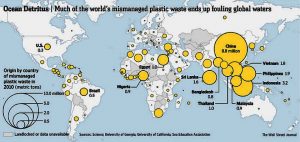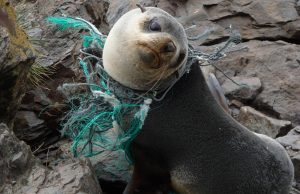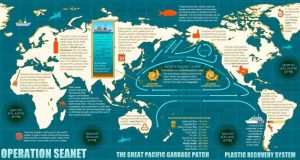Plastics – Stop Littering – We need to make a change !
by S. Oram (new blogger)
Where do you throw your plastics and trash when you are done with it? I would hope you say you RECYCLE ! Because just throwing that container away by mixing it with the normal trash or discarding out the window creates problems. Part of this problem is POLLUTION. This pollution creates visual aesthetic issues, but also damages habitat and threatens the land, air, and sea animals. Did you ever stop and think about how these things can affect the animals outside? Most plastic waste comes from third world countries especially in China, but we can still make a difference.
 https://goo.gl/images/38xfsv Online Source –
https://goo.gl/images/38xfsv Online Source –
In the 1970s, the National Academy of Sciences estimated about 45,000 tons of garbage and waste was being tossed and thrown in the ocean. Since initial estimate, it has gotten even worse. Many people throw things in the ocean and don’t think about the animals in it or the other uses downstream. The materials can get wrapped around the animals or some of the animals eat. The animals become hurt, sick, and die. Littering can kill marine life and destroy habits. Some people don’t stop to think about the animals and their safety. Over 100,000 marine mammals and 1 million sea birds are killed each year from plastic pollution and 6 million tons of debris, i.e., a ton is 200 lbs , enters the ocean each year. It is time to say – Enough!

Sad there is no reason to create this type of pain and suffering.
Did you know it can take up to 450 years for plastic bottles to decompose? This does not appear to be true. “Scientists Thought It Took Thousands of Years for Plastic to Decompose – It May Only Be Decades” and “A more recent study revealed that PET degrades more rapidly than previously thought in ocean water due to the presence of metal ions in the water. Fifty percent degradation was said to occur in 4.5 years and 100% degradation in 72 years.”
Where is most of this plastic? (Operation Seanet)
Here is a list of wastes that go in the ocean and how long it takes to decompose.
Foam cups and tin cans – up to 50 years.
Plastic bottles depending on type and environment could be up to 450 years (Source)
Fine fishing net up to 600 years (much longer for heavier nets).
Cigarette butts- 1 – 5 years.
Plastic bags- 10 – 20 years (Some putting this debris in a plastic bag is not good enough) . The bags breakdown and this it may take 100s of years for the content to decompose.
SO – Simply Bagging the Trash is Not a Solution and Putting the Plastic in a Landfill is the Wrong Choice. We must make every effort to recycle, reuse, and then put our young minds together and help to clean up our oceans, beaches, and landscapes and develop better solutions.
My call to action:
- Please think twice before littering and think twice before throwing stuff away, especially plastic bottles.
- Try Going Bottleless –We tried and we saved money.
- Pick up litter and Recycle – Participate in local clean up events.
- Try to kick the plastic habit.
- Check out Operation – Seanet
other Articles
PFAS Cycle – https://shop.knowyourh2o.com/blogs/news/pfas-and-forever-chemicals-a-new-man-made-cycle-the-pfas-cycle-that-must-be-broken
Plastics and the Environment – Debunking Myths and Responsible Practices
Wildlife and Lead Poisoning – Lead is not Just a Problem for Humans
Sources:
http://www.perseus-net.eu/site/content.php?locale=1&sel=517&artid=565
https://www.dpaw.wa.gov.au/management/marine/marine-parks-wa
http://www.bluebird-electric.net/oceanography/Ocean_Plastic_International_Rescue/Logistics_Recycling_Plastic_Ocean_Cleanup_Cargo_Operations.htm
Keystone Clean Water Team – Groundwater Foundation Library – Links to Educational Webinars – Groundwater Guardians Pennsylvania
“The Groundwater Foundation’s library of FREE educational webinars, available on-demand.”
The Keystone Clean Water Team (KCWT) -Carbon County Groundwater Guardian Program (CCGG) is a 501(c)(3) non-profit, volunteer, environmental education organization which provides homeowners with information on private wells, water quality and quantity, and septic systems. We are dedicated to protecting private well owners from illnesses caused by our drinking water. We advance good groundwater stewardship by raising awareness on a variety of groundwater issues that affects everyone with a private water supply. We can help you get your water tested at the lab of your choice and explain the test results.
[amazon_link asins=’1612121691′ template=’ProductCarousel’ store=’webdespro-20′ marketplace=’US’ link_id=’a7021113-ef1d-11e7-8d97-1fd59a8acfaf’]
Click on the webinar title for a description, presenter information, length, and link to view.
-
Becoming a Groundwater Guardian Green Site: An Overview of the Application Process
-
Introduction to Groundwater Guardian Green Sites
Our Educational Booklet on Groundwater
Looking for a speaker related to Well Issues, Septic Systems, or Groundwater in Pennsylvania – contact: http://www.pacleanwater.org
News Releases: Water Quality Association Perfluroinated Chemicals PFCs, PFOS, and PFOA
Part of National Defense Authorization Act headed to President’s desk
LISLE, Ill. – The Water Quality Association has voiced its support for a provision in the National Defense Authorization Act (NDAA) that authorizes a nationwide health study on the implications of perfluorinated chemicals (PFCs) such as PFOA on drinking water. The language was authored by Senator Jeanne Shaheen (D-NH).
“This is an important step forward in the research needed to track the health effects of PFCs,” said WQA Executive Director Pauli Undesser. “We thank Senator Shaheen for making this a national priority.”
The NDAA is annual legislation that authorizes defense priorities for the fiscal year. The bill has been approved by both the U.S. House and Senate and is now headed to the President’s desk for his signature. Once signed into law, it will mandate the Agency for Toxic Substances and Disease Registry to conduct the first-ever nationwide study on the impact of those exposed to PFCs in drinking water. However, Congress will also need to appropriate the $7 million to conduct the public health study.Earlier this year, the Environmental Working Group and Northeastern University identified PFCs in the drinking water of 15 million Americans in 27 states. The new research includes an interactive map that identifies where the contamination was identified.
What are (including PFOA and PFOS)?
PFCs are man-made. They are used in a broad range of applications including fire-fighting foams, non-stick coatings, food packaging and many other industries.
What are the potential health effects from PFOA and PFOS?
Studies have found PFOA and PFOS in the blood samples of the general human population and wildlife nationwide. Studies also indicate that continued exposure to low levels of PFOA in drinking water may result in adverse health effects. These chemicals bioaccumulate in living organisms compounding the exposure and potential impacts on human health.
Residents should have their drinking water tested through a certified water-testing laboratory. Homeowners can check with the Water Quality Association at PFOS to find a water quality professional or connect with a certified testing lab through the USEPA (http://water.epa.gov/scitech/drinkingwater/labcert/statecertification.cfm).
This is a copy of a press release from: WQA is a not-for-profit trade association representing the residential, commercial, and industrial water treatment industry. Since 1959, the WQA Gold Seal certification program has been certifying products that contribute to the safe consumption of water. The WQA Gold Seal program is accredited by the American National Standards Institute (ANSI) and the Standards Council of Canada (SCC).
Geologists uncover Antarctica’s fossil forests
“Prehistoric polar forests were built for survival, but were not hardy enough to live in ultra-high concentrations of atmospheric carbon dioxide. A geologist is studying the tree fossil record in Antarctica from a mass extinction 250 million years ago, looking for clues to how greenhouse gases affected plants — then and now.”
By the trip’s end, the geologists had found fossil fragments of 13 trees. The discovered fossils reveal that the trees are over 260 million years old, meaning that this forest grew at the end of the Permian Period, before the first dinosaurs.
“People have known about the fossils in Antarctica since the 1910-12 Robert Falcon Scott expedition,” said Gulbranson, a paleoecologist and visiting assistant professor in UWM’s Department of Geosciences. “However, most of Antarctica is still unexplored. Sometimes, you might be the first person to ever climb a particular mountain.”
Learn More – University of Wisconsin-Milwaukee- Erik Gulbranson,
Featured Course – Restoring Urban Ecosystems
“The geologic record shows us the beginning, middle and end of climate change events,” Gulbranson said. “With further study, we can better understand how greenhouse gases and climate change affect life on Earth.” (Question- Does his statement put the cart before the horse?)
Earth’s Magnetic Poles Swapping ??
“The Earth’s magnetic field” surrounds our planet like an invisible force field – protecting life from harmful solar radiation by deflecting charged particles away. Far from being constant, this field is continuously changing. Indeed, our planet’s history includes at least several hundred global magnetic reversals, where north and south magnetic poles swap places. So when’s the next one happening and how will it affect life on Earth?
During a reversal the magnetic field won’t be zero, but will assume a weaker and more complex form. It may fall to 10% of the present-day strength and have magnetic poles at the equator or even the simultaneous existence of multiple “north” and “south” magnetic poles.
Geomagnetic reversals occur a few times every million years on average. However, the interval between reversals is very irregular and can range up to tens of millions of years.
There can also be temporary and incomplete reversals, known as events and excursions, in which the magnetic poles move away from the geographic poles – perhaps even crossing the equator – before returning back to their original locations. The last full reversal, the Brunhes-Matuyama, occurred around 780,000 years ago. A temporary reversal, the Laschamp event, occurred around 41,000 years ago. It lasted less than 1,000 years with the actual change of polarity lasting around 250 years.
Power cut or mass extinction? (Read More)
For the climate group – “The difficulties of predicting the weather beyond a few days are widely known, despite us living within and directly observing the atmosphere. Yet predicting the Earth’s core is a far more difficult prospect, principally because it is buried beneath 3,000km of rock such that our observations are scant and indirect”
Training Profile – “Tracking Carbon“?
Supporting Solid Organizations in the Wyoming Valley – Buy a Poinsettia – Kingston Rotary
We always try to help the community, Kingston Rotary is holding a poinsettia sale. There biggest project to date just happened this year, and that is the Forty Fort Park Pavilion. If you are driving down Wyoming Avenue take a look at this structure and the picnic tables etc, that are there. This project cost over $ 50,000, and is completely paid for through grants and our fundraising such as this. Another major project they did over 25 years ago, was the Church Street Park in Kingston. This park was turned over to the borough and is still in use today. They also support many Non profits such as Candy’s Place and WVCA, see Poinsetta order form flyer 2017 and other historic projects in area.
[amazon_link asins=’B0001R050W’ template=’ProductAd’ store=’webdespro-20′ marketplace=’US’ link_id=’61ea1632-ca43-11e7-9fa3-51da19a06d5e’]
We need to replenish our treasury so we can continue to do these projects. These poinsettias are beautiful plants, and are grown by a local grower (BUY LOCAL) , so not only are you helping Rotary you are helping a local business. They make a beautiful holiday decoration for your office. You can email your orders, or just print out the sheet and fax or hand to me then next few weeks, As in the past if you order 10 plants or more I will deliver to your place of business.
Details Contact:
Edward W. Stanks Jr., C.P.A.
458 Wyoming Avenue
Kingston, Pa. 18704
Phone: 570-288-9990
Fax: 570-288-2553
Job VACANCY ANNOUNCEMENT Executive Director, Pike County Conservation District, Pike County, Pennsylvania
VACANCY ANNOUNCEMENT
EXECUTIVE DIRECTOR, PIKE COUNTY CONSERVATION DISTRICT
Pike County Conservation District (PCCD) is accepting applications for a full-time Executive Director (ED). Challenging position responsible for management of the overall administration and supervision of Conservation District programs, personnel, and operations implementing the Conservation District Mission within Pike County. Must be a leader, a service-oriented individual with high ethical standards and excellent interpersonal, communication and organizational skills. Must have a knowledge of current natural resource conservation issues, practices and programs. ED supervises a staff of 7. Pike County position with a competitive salary and benefit package. Pike County is an EOE. MINIMUM QUALIFICATIONS: Bachelor’s degree in natural resource management, environmental science or related field with demonstrated experience of at least two (2) years (including supervisory experience), or any equivalent combination of experience. Must possess and maintain a valid Pennsylvania driver’s license. Clear Pennsylvania State Police criminal background check, all Child Abuse History Clearances and FBI fingerprint clearance are required. Applicants must submit: 1) Letter of Interest addressed to Conservation District Selection Committee and 2) A Detailed Resume including references. Send to ATTENTION OF: Selection Committee, Pike County Conservation District, 556 Route 402, Hawley, PA 18428. Must be received by PCCD no later than January 5, 2018 closing date for applications. Hard copy submissions preferred. Email submissions send only to scorrigan@pikepa.org. Please read minimum qualifications thoroughly and demonstrate you meet requirements in the materials you submit.
THANK YOU
Sally Corrigan, Executive Director
Pike County Conservation District
scorrigan@pikepa.org
570-226-8220 (t) Ext. 1338
www.pikeconservation.org
Training Courses
Professional Management Courses including Project and Non-profit Management
Water Resource Training Courses – Wetlands, Smart Development, Sustainability, Stream Restoration, and More.
National Pipeline Mapping System – National Gas and other Hazardous Liquids Pipeline
The U.S. Department of Transportation offers the public access to their National Pipeline Mapping System via a free online, interactive map and an iPhone app. It displays general information for pipelines carrying gas and hazardous liquids, liquefied natural gas plants, and breakout tanks within a county-wide zone.
[amazon_link asins=’1507635796′ template=’ProductAd’ store=’webdespro-20′ marketplace=’US’ link_id=’27ce6143-c4de-11e7-bc84-558f4cd9c907′]
While the mapping system is not to be used as a precise identifier of pipelines in a location, the public can access general knowledge about potential sources of contamination in their area. By turning on the visual indicators for accidents and incidents in the area, it’s possible to judge remediation efforts based on past events. Watershed organizations can submit a data request report or find the companies that are operating pipelines in your area. The system is also a useful tool for community outreach and education efforts, whether you’re simply identifying topics for public forums and workshops or looking critically at local remediation efforts.
Featured Training Program
Susquehanna River Basin Commission – Water Withdraws – Fact Sheet Registration.
The Susquehanna River Basin Commission (Commission) is contacting you because you may have clients who are affected by a new program for registration of unapproved water withdrawals and consumptive water uses in the Basin. We are seeking your assistance to help ensure that facility managers are aware of and complete registration by the deadline of December 31, 2019.
An initial contact letter and registration factsheet (GFregistration-grandfathered-water-withdraws-factsheet) was sent to more than 1,300 facilities by direct mail this week. The targeted grandfathered facilities/sources are those where water withdrawals or consumptive uses equal or exceed the regulatory thresholds, but began operating before the applicable regulations became effective. These water withdrawals and uses are generally considered to be exempt from obtaining a Commission docket, provided there has been no environmental harm and no changes are made at the facility.
[amazon_link asins=’0060548312′ template=’ProductAd’ store=’webdespro-20′ marketplace=’US’ link_id=’d8e30f40-c0cc-11e7-a986-b782313bfb61′]
The Commission has initiated the registration effort after reviewing the results of our Cumulative Water Use and Availability Study that highlighted major gaps in the data the Commission needs in order to effectively manage the water resources of the Basin. We estimated that there are possibly more than 700 older, unpermitted facilities with an estimated water use of nearly one billion gallons per day. If accurate, this volume of water use is roughly equal to the total amount currently accounted for, and managed, by the Commission across the entire Basin.
Informational webinars explaining the registration program will be conducted by Commission staff on November 14 and December 13, 2017. To register for a webinar, visit www.srbc.net/grandfathering-registration.
If you need additional information or assistance, visit the website or contact Commission staff at GFregistration@srbc.net.
Thank you,
Susquehanna River Basin Commission

